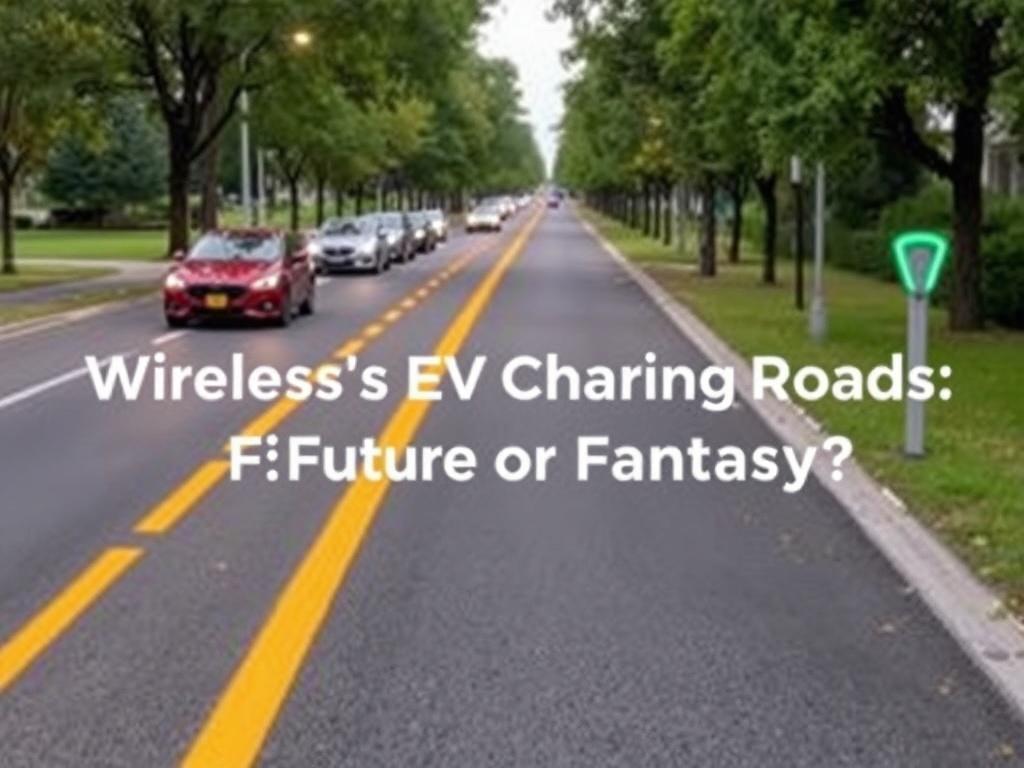- Understanding Wireless EV Charging Technology
- How Does Wireless EV Charging Work on Roads?
- The Benefits of Wireless EV Charging Roads
- 1. Elimination of Range Anxiety
- 2. Convenience and Time Efficiency
- 3. Potential Environmental Benefits
- 4. Infrastructure Modernization
- The Challenges and Limitations of Wireless EV Charging Roads
- High Initial Costs and Infrastructure Complexity
- Energy Efficiency and Power Loss
- Standardization Issues
- Safety and Health Concerns
- Current Developments and Real-World Trials
- Notable Projects Around the World
- Technological Innovations Driving Progress
- The Economic Implications of Wireless EV Charging Roads
- Cost-Benefit Analysis
- Impact on EV Market Growth
- Private vs. Public Investment
- Wireless EV Charging Roads and Sustainability
- Integration with Renewable Energy Sources
- Reducing Environmental Impact of Charging Stations
- Encouraging Behavioral Change
- Potential Concerns and Public Perception
- Safety and Health Myths
- Privacy and Data Security
- Equity and Accessibility
- Comparing Wireless EV Charging Roads to Other Charging Solutions
- Looking Ahead: What’s the Future of Wireless EV Charging Roads?
- Key Factors Influencing Adoption
- Conclusion
Electric vehicles (EVs) have undeniably revolutionized the way we think about transportation, offering a greener, more sustainable alternative to traditional gasoline-powered cars. Yet, one of the biggest concerns among EV owners and potential buyers is the challenge of charging. Plugging in your car, waiting hours for a full battery, worrying about range anxiety—these are common issues slowing down the mass adoption of EVs. Enter the idea of wireless EV charging roads, an innovative concept that promises to change everything. Imagine driving down a highway and having your EV charge seamlessly as you go, no cables, no plugs, no stops. But is this truly the future of transportation, or just a fantasy we’re chasing? Let’s dive into the technology, the challenges, and the potential impact of wireless EV charging roads.
Understanding Wireless EV Charging Technology
Before we can fully grasp the idea of wireless EV charging roads, it’s important to start with the basics. Wireless charging technology, also known as inductive charging, uses electromagnetic fields to transfer energy between two objects without direct contact. For electric vehicles, this involves embedding coils beneath the road surface and within the car itself. When the EV drives over the road, energy transmits wirelessly from the coils in the pavement to the coils in the vehicle, charging the battery as the car moves.
This concept isn’t entirely new—wireless phone chargers using similar technology have been popular for years. But scaling this up for EVs, especially on public roads, introduces complexities. The distance between transmitter and receiver coils, the speed of the vehicle, and energy efficiency are all critical factors that engineers are trying to optimize.
How Does Wireless EV Charging Work on Roads?
To picture wireless EV charging roads, imagine a system structured in layers:
- Embedded Coils in the Road: These coils are installed beneath the road surface at regular intervals, designed to create electromagnetic fields as vehicles pass over them.
- Power Supply: The coils are connected to an energy source, often tied into the electrical grid or renewable energy setups like solar or wind power.
- Onboard Receiver Coils: EVs are equipped with receiver coils mounted on the underside of the car. These coils pick up the energy transmitted through the road and convert it into electrical power to recharge the battery.
- Control System: Communication between the road and the vehicle ensures energy transfers only when needed, maximizing efficiency and safety.
While stationary wireless charging pads exist and are available in some parking lots, moving wireless charging roads are far more complex. The system must compensate for vehicle speed, positioning, and variable traffic conditions while ensuring safety for all road users.
The Benefits of Wireless EV Charging Roads
If perfectly implemented, wireless EV charging roads could offer numerous advantages that reshape our daily driving experience.
1. Elimination of Range Anxiety
Range anxiety—the fear that an EV’s battery will run out before reaching the next charging station—is one of the biggest stumbling blocks for potential electric car buyers. Wireless roads can minimize this worry by providing continuous or frequent charging opportunities, allowing drivers to keep their batteries topped up as they travel.
2. Convenience and Time Efficiency
Gone are the days of waiting at public charging stations or planning long trips around charging stops. Wireless charging roads facilitate charging without interrupting journeys, making EV ownership more convenient for busy individuals and long-distance travelers alike.
3. Potential Environmental Benefits
By integrating wireless EV charging with renewable energy sources, these roads could support a cleaner energy ecosystem. Imagine highways powered partially or entirely by solar panels feeding the wireless charging system, reducing our reliance on fossil fuels and lowering carbon emissions even further.
4. Infrastructure Modernization
Deploying wireless EV charging networks encourages governments and private sectors to upgrade existing transportation infrastructure, paving the way for smarter, more efficient roads optimized for the electric age.
The Challenges and Limitations of Wireless EV Charging Roads
As promising as wireless EV charging roads sound, the reality presents significant hurdles.
High Initial Costs and Infrastructure Complexity
Installing wireless charging systems beneath busy roads involves substantial investment in construction, materials, and ongoing maintenance. Retrofitting existing highways is especially challenging, as it requires road closures and complex coordination with local authorities.
Energy Efficiency and Power Loss
Wireless charging, particularly at a distance (between the road and moving vehicle), faces efficiency losses. Transmission can lose a significant portion of power due to misalignment or air gaps, meaning more energy input is necessary to achieve the same output compared to wired charging.
Standardization Issues
For wireless charging roads to become mainstream, car manufacturers, infrastructure providers, and governments must agree on standardized technologies and protocols. Currently, no universally accepted standard exists, which presents a barrier to widespread adoption.
Safety and Health Concerns
Electromagnetic fields generated by wireless charging coils have raised concerns about potential health risks for drivers, passengers, pedestrians, and wildlife. Although current studies show no conclusive harm at regulated exposure levels, public perception remains cautious.
Current Developments and Real-World Trials
Multiple countries and companies are actively researching and testing wireless EV charging roads, turning the concept from fantasy to tangible possibility.
Notable Projects Around the World
| Country | Project Name | Description | Status |
|---|---|---|---|
| South Korea | Electric Road Project | Installation of wireless charging coils on a highway segment to test in-motion EV charging under real traffic conditions. | Ongoing trials |
| Sweden | ERoadArlanda | A 2 km electrified road near Stockholm using both overhead and wireless charging methods for trucks and buses. | Operational pilot |
| United States | Illinois Wireless Charging Demonstration | Testing wireless charging on public roads in controlled environments to assess feasibility and public safety. | Research phase |
| China | Wireless Charging Bus Lines | Implementation of wireless charging infrastructure along select bus routes to reduce charging downtime. | Active projects |
These projects are helping to refine the technology, understand the challenges, and build public acceptance.
Technological Innovations Driving Progress
Advances in high-frequency power transfer, dynamic alignment controls, and energy management systems continue to push wireless EV charging closer to practicality. Artificial intelligence and sensor technology are being integrated to optimize charging efficiency based on vehicle weight, speed, and battery status.
The Economic Implications of Wireless EV Charging Roads
Beyond the technical aspects, wireless charging roads carry significant economic considerations.
Cost-Benefit Analysis
Deploying wireless roads is capital-intensive, requiring millions in upfront infrastructure spending. However, as EV adoption grows, the economic benefits could include:
- Reduced dependence on oil imports
- New job opportunities in green technology sectors
- Lowered healthcare costs due to reduced air pollution
- Boosts to local economies from infrastructure projects
Governments will have to assess whether the long-term gains justify the short-term costs.
Impact on EV Market Growth
Wireless charging roads could catalyze EV market expansion by addressing one of the main concerns—charging convenience. Increased consumer confidence may lead to higher sales, stimulating the automotive industry and related supply chains.
Private vs. Public Investment
Collaborations between public authorities and private enterprises will be essential. Toll-like models, where some users pay for access to electrified roads, and government subsidies could play a role in making projects financially viable.
Wireless EV Charging Roads and Sustainability
The promise of wireless EV charging roads aligns strongly with global sustainability goals. Transitioning to electric mobility is a critical step in reducing greenhouse gas emissions, and charging infrastructure plays a pivotal role.
Integration with Renewable Energy Sources
Wireless roads equipped with solar panels or connected to wind farms could ensure that the energy powering EVs is clean and renewable, closing the loop in sustainable transportation.
Reducing Environmental Impact of Charging Stations
Traditional charging stations require land, physical structures, and materials which carry their own environmental footprint. Wireless charging roads potentially reduce the need for extensive station networks, minimizing land use.
Encouraging Behavioral Change
By making charging effortless and invisible, wireless charging roads could encourage more drivers to switch to EVs, accelerating the global transition away from fossil fuels.
Potential Concerns and Public Perception
Despite the excitement about wireless charging roads, public acceptance is critical to their success.
Safety and Health Myths
Misinformation about electromagnetic fields may lead to resistance from communities. Providing clear, science-based education will be crucial to overcome fears.
Privacy and Data Security
As these systems rely on communication between vehicles and infrastructure, concerns about data privacy and cybersecurity arise. Transparent policies and robust security measures must be in place.
Equity and Accessibility
Will wireless charging roads be available only in wealthy urban areas, or will rural and underserved communities benefit as well? Ensuring equitable access will be important to avoid widening the digital divide.
Comparing Wireless EV Charging Roads to Other Charging Solutions

It’s helpful to see wireless EV charging roads in the broader context of EV charging methods.
| Charging Method | Advantages | Disadvantages |
|---|---|---|
| Plug-in Charging Stations | Widely available; fast charging available; established technology | Requires stationary stops; can cause congestion at popular stations; cable management |
| Wireless Stationary Chargers | Convenient, no cables; good for home or parking lots | Slower than wired fast chargers; limited power transfer distance |
| Wireless EV Charging Roads | Charging while driving; reduces range anxiety; seamless energy transfer | High infrastructure costs; technical complexity; energy efficiency challenges |
| Battery Swapping Stations | Fast “refueling” by swapping batteries; no waiting times | Requires standardized batteries; costly infrastructure; limited adoption |
Each charging method has its place in a diverse and growing EV ecosystem, with wireless charging roads acting as a complementary technology rather than a complete replacement.
Looking Ahead: What’s the Future of Wireless EV Charging Roads?
The journey toward wireless EV charging roads being widely deployed is gradual and filled with both promise and pitfalls. As technology advances and investments flow, pilot projects will expand, providing valuable data and lessons. Governments, industry leaders, and consumers will play roles in shaping how quickly and effectively these systems become part of everyday life.
Urban planners and automotive manufacturers are starting to collaborate closely, integrating vehicle design with road infrastructure in ways we’ve never seen before. Smart cities of the future might boast highways that keep electric buses, trucks, and private cars charged and ready without a single stop.
Moreover, as wireless charging roads become more efficient and affordable, they could spark innovations in autonomous electric vehicles, enabling fleets to operate continuously and efficiently.
Key Factors Influencing Adoption
- Technological breakthroughs in energy transfer efficiency and system durability
- Cost reductions through mass production and improved installation methods
- Government policies supporting green infrastructure and clean transportation
- Public acceptance and willingness to embrace new infrastructure
It’s clear that wireless EV charging roads hold transformational potential, but realizing that potential will take time, collaboration, and ongoing innovation.
Conclusion
Wireless EV charging roads represent an exciting frontier in electric vehicle technology, offering the tantalizing possibility of driving miles without ever needing to stop and plug in. While this concept seems futuristic—and in some ways, still a dream—it is steadily moving closer to reality through innovative research, pilot programs, and growing collaboration across industries and governments. The benefits, from eliminating range anxiety to encouraging cleaner transportation, are compelling, yet the challenges—including high costs, infrastructure complexity, energy efficiency, and safety concerns—are formidable. As the world seeks sustainable solutions to transportation’s environmental impact, wireless EV charging roads could play a pivotal role in transforming our highways and daily commutes. Whether this vision becomes commonplace in the next decade or remains a niche solution hinges on technology advancements, investment priorities, and public readiness. Ultimately, wireless EV charging roads invite us to imagine a future where clean energy flows invisibly beneath our wheels, powering the journey ahead with quiet efficiency and endless possibility.
Как вам статья?







